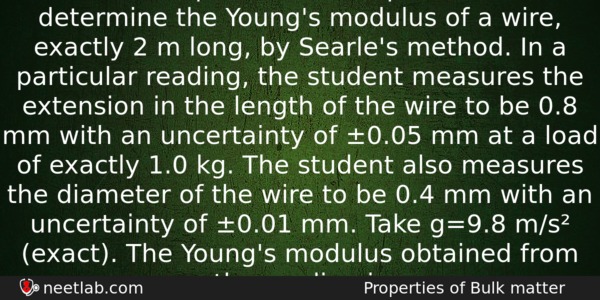| ⇦ | 
| ⇨ |
A student performs an experiment to determine the Young’s modulus of a wire, exactly 2 m long, by Searle’s method. In a particular reading, the student measures the extension in the length of the wire to be 0.8 mm with an uncertainty of ±0.05 mm at a load of exactly 1.0 kg. The student also measures the diameter of the wire to be 0.4 mm with an uncertainty of ±0.01 mm. Take g=9.8 m/s² (exact). The Young’s modulus obtained from the reading is
Options
(a) (2.0±0.3)x10¹¹ N/m²
(b) (2.0±0.2)x10¹¹ N/m²
(c) (2.0±0.1)x10¹¹ N/m²
(d) (2.0±0.05)x10¹¹ N/m²
Correct Answer:
(2.0±0.2)x10¹¹ N/m²
Explanation:
No explanation available. Be the first to write the explanation for this question by commenting below.
Related Questions: - A capacitor of capacitance 100μF is charged by connecting it to a battery of voltage
- The output of OR gate is 1(one)
- A uniform chain of length L and mass m is kept on a smooth table. It is released
- A magnetic field of 1600 A/m produces a magnetic flux of 2.4 x 10⁻⁵ Wb
- The horizontal and vertical components of earth’s magnetic field at a place
Topics: Properties of Bulk Matter
(130)
Subject: Physics
(2479)
Important MCQs Based on Medical Entrance Examinations To Improve Your NEET Score
- A capacitor of capacitance 100μF is charged by connecting it to a battery of voltage
- The output of OR gate is 1(one)
- A uniform chain of length L and mass m is kept on a smooth table. It is released
- A magnetic field of 1600 A/m produces a magnetic flux of 2.4 x 10⁻⁵ Wb
- The horizontal and vertical components of earth’s magnetic field at a place
Topics: Properties of Bulk Matter (130)
Subject: Physics (2479)
Important MCQs Based on Medical Entrance Examinations To Improve Your NEET Score
18000+ students are using NEETLab to improve their score. What about you?
Solve Previous Year MCQs, Mock Tests, Topicwise Practice Tests, Identify Weak Topics, Formula Flash cards and much more is available in NEETLab Android App to improve your NEET score.
Share this page with your friends

Leave a Reply